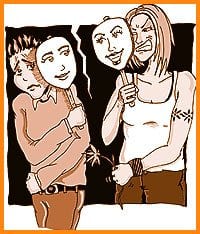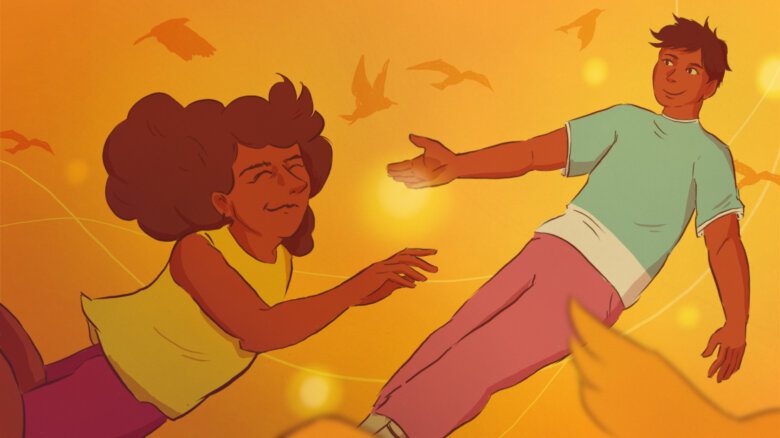Susie is describing a night a year or so ago, towards the end of her on-again, off-again tumultuous relationship. She fidgets with her coffee cup and I know she’s telling me something she’s told very few other people.
“She was in such a rage. We’d had fights before – bad ones, but this time was different. This time I was scared,” says Susie (not her real name; any name without a surname in this story has been changed to protect the privacy of the women).
She’d invited her partner home, just one more time, and the conversation became tense. Suddenly her partner was up, fuming about the room, looking for something to throw. A small plastic storage bin shattered on the wall beside Susie’s head. Then her partner was on top of her, her hands tight around Susie’s throat.
“I felt like she wanted me to fight back, so I decided not to resist. I didn’t really have the will to, anyways,” she says uncomfortably. “I was at too low a place in my life and this was like the final straw. I could feel myself losing air and I thought I was going to pass out. I thought, maybe she is going to kill me. But then, I don’t know why, she just let go.”
Too afraid to risk more of an outrage, Susie spent the rest of that night lying in bed beside someone who’d made a serious attempt to strangle her. Such is the tiptoe, placating technique of finding your way out of an abusive situation. You’ve been hit, humiliated, insulted, threatened, upbraided, beaten or defeated. More often than not your only choice is to apologize, acquiesce, shut down or shut up.
Susie didn’t expect this in a relationship with another woman. Being with women was, in part, about wanting to have a love life without the battles of sexism. But a mistake many people make about gay relationships is that they’re devoid of power imbalances, inequality and abuse.
“Especially in the communities of feminist anti-violence activism, the priority has been about stopping men’s violence against women,” says Kathleen O’Connell, a counsellor with the Anti-Violence Program of the Parkdale Community Health Centre. “Nobody was really prepared to accept that women can be violent too, or that gay men could be violent with each other.”
Such blinders are worn not just by the larger community but sometimes by those in relationships themselves. Jean is a dedicated anti-abuse activist and educator who faced the difficult experience of applying what she knew in her work to her own life.
“I was running anti-abuse workshops at the time,” she admits. “I’d be up in front of a bunch of people, describing what an abusive relationship is like and suddenly I’d think, ‘I’m talking about me.'”
The truth about abuse in intimate relationships is that no particular relationship, no sexual orientation, has a monopoly. It can happen to anybody. The difficulty in not getting drawn in is pretty much the same for anyone – usually your heart gets caught first.
“Abusive relationships often have a magnetic quality to them,” cautions Hershel Russell, a psychotherapist in private practice. “They can be very intense, like a one-of-a-kind partnership, which also makes them very hard to leave.”
I understand this all too well. With a clarity like it was yesterday I remember the day, three or four months into a new relationship, I stood in my kitchen and looked at my hands. In the one I weighed love, of an exhilarating and intense variety, and in the other, abuse. Two very distinct entities, like my two hands, yet inseparably bound to the same relationship.
Hazel also understands. “I would have to say that with her, I experienced the highest comfort level I’ve experienced with anyone, on every level.” Yet the partner of whom she speaks insulted her, criticized her, degraded her, took over her home and use of her car, nearly broke her wrist one day and on another, beat her and choked her until she blacked out.
It’s a troubling dynamic that’s perhaps impossible to grasp until you’ve experienced it yourself. That was my realization. For all my feminist background, familiarity with women’s stories, listening to friends and attending protests, I hadn’t quite got that someone who abuses, even who abuses terribly, can also be someone whose qualities or charm compel you to love them, sometimes very much.
“Oh yes, people who are abusive are often very charming, very amiable to the outside world,” agrees Howard Shulman, coordinator of the 519 Community Centre’s Anti-Violence Program. “It makes them very attractive on a first impression, and can make it hard for anyone outside the relationship to believe abuse is going on.”
Jean says she and her partner, for example, were “an upstanding couple in the community.” When Jean finally attempted to talk to a co-worker about her situation, her troubles weren’t taken seriously.
“It was emotional abuse, mostly. Lots of criticism, humiliation, huge fights over nothing that she had to win,” she recounts. “People found it hard to believe. I discovered if I told them she had also hit me, and broke things all the time, they started to see.”
Emotional abuse is too easily discounted as simply an unhealthy relationship dynamic. But name calling, insults, reprimands, constant criticism and second-guessing, unpredictable mood swings, pickiness and quicksand-like arguments that last for hours and hours are all techniques aimed, consciously or not, at breaking down a partner’s confidence, self-esteem, independence and ability to resist.
Physical abuse rarely exists without emotional abuse, but emotional abuse can be thorough and devastating without much threat of physical harm. In fact, not hurting someone physically can be part of an abusive dynamic.
“She’d put her hands on me like that before,” says Susie, recalling other incidents. “But I wasn’t afraid she would actually hurt me because she used to tell me I wasn’t worth enough for her to pay the consequences. And I knew she meant it.”
Periods of relative calm, even blissful togetherness, are generally one rotation in what’s known as the cycle of abuse: calm, honeymoon periods, followed by a gradual (or sudden) build-up of tension, culminating in an incident or period of abuse, followed by another honeymoon period, often brimming with fabulous apologies and exhilarating reconciliation.
“I have to say there were strings of brilliance, absolute brilliance,” admits Hazel, speaking of the relationship she finally fled by making a mad naked dash out of her house, carrying her clothes, her valuables and her car keys. “It’s what kept me coming back.”
In true pop psychology theory, being rewarded intermittently is the strongest form of reinforcement. It’s what’s called living in the “potential” – the possibility of working through all the hard stuff to the nirvana on the other side. In a healthy relationship it’s good practice to give your partner some benefit of the doubt; in an abusive situation that kind of generosity is an acute and dangerous trap.
Indeed, most healthy relationship practices backfire when applied to an abusive dynamic. Take, for example, the willingness to accept responsibility, and be open to self-reflection and self-examination. In an abusive relationship, that’s an open invitation for your partner to tell you what’s wrong with you and to toss entire responsibility for the health of the relationship onto your shoulders.
“She would tell me I deserved what I was getting,” says Hazel. “It was typical. I would break up with her, then go back to her and when things got bad, she’d say, ‘Well, you chose to be with me so it must be what you want.'”
If it sounds crazy-making, it is. If it sounds like it should be easy to walk away from, it isn’t. In fact, the longer an abusive relationship continues, the longer it’s likely to continue, as the partner who’s abused loses confidence, becomes isolated from friends, family and community, loses the ability to judge what’s healthy and what’s not, and becomes absolutely governed by the behaviour of her lover.
That scenario is what made me cut it off finally, despite several previous attempts. Having endured hours and days of devastation and bewilderment, endless, detailed, spiralling arguments, constant blame and correction, and frequently an absolute moratorium on what I was allowed to discuss, I took to heart what many around me cautioned: it only gets worse and it only gets harder to get out.
Hazel is philosophical about her experience. “Things happen for a reason,” she says. “What I have now is a life experience that’s more profound than any kind of formal learning, better than any degree.”
That’s a difficult resolution. Myself, I spent a lot of time wondering, Why me? What the hell did I do to earn that? Of course, nobody “earns” or deserves to be abused. The trick is not in knowing that, but in being able to recognize abuse from the inside, being able to step aside from the barbs and blows and the sometimes desperate need to make everything all right, and realize that what’s going on is not okay.
“I would say to anyone that they should trust their instincts,” advises Jean. “If something feels wrong, check it out with other people. Not just one or two, but lots.”
And never too soon. Disengaging from an abusive relationship can take a good deal of time, repeated and concentrated efforts and unswerving determination.
Having been out of her relationship now for longer than she was in it, Hazel offers, “I now have a deep respect for anyone in that circumstance, and especially for those who are able to get themselves out.”

 Why you can trust Xtra
Why you can trust Xtra


